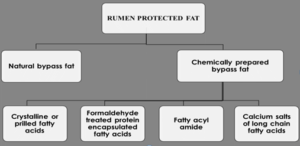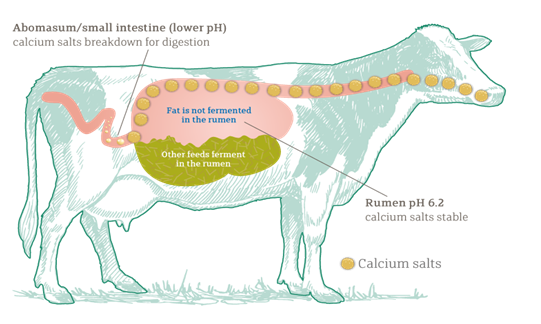IMPORTANCE OF BYPASS FAT – IN DAIRY ANIMALS DIET
In India, buffaloes contribute a major part of high fat milk and during early lactation, the amount of energy required for maintenance of body tissues and milk production often exceeds the amount of energy available from the diet, causes negative energy balance , thus forcing mobilization of body fat reserves to satisfy energy requirement. Due to the decreased feed intake at the end of gestation, the negative energy balance period often starts prior to calving . The negative energy balance in early lactation causes delayed post-partum ovarian activity , apart from affecting peak milk yield and overall lactation yield. The level of non-esterified fatty acids (NEFA) increases in plasma as a consequence of body fat mobilization and leads to hepatic lipidosis. In initial lactation to meet their energy requirement of high yielding crossbred animals, they should be fed with either higher level of cereal grains or fed on a diet supplemented with bypass nutrients. But excess of cereal grains in the diet can cause rumen acidosis predisposing the animals to ill health, animal goes off feed, leading to drop in milk yield.
Use of dietary fat in dairy animals
In ration of early lactating or high yielding dairy animals, fat is helpful in increasing the energy density of the diet which is 2.25 times than carbohydrate. The supplementation of fat in animals rations checks negative energy balance during early lactation, acidosis and laminitis, subordinate heat production and integrate fatty acid into milk fat.
Rumen-active fat
Raw edible oil if given beyond a certain proportion as a source of fat for increasing energy density of the ration may adversely affect fiber digestion and bind divalent mineral ions. Fats which are not protected causes physical and chemical changes in the microbial fermentation of feed that are generally negative, and feeding of free or unprotected fat above 1% level has a depressing effect on rumen cellulolytic microbial activity . Milk fat is criticized for having higher content of saturated fatty acids and lower content of polyunsaturated fatty acids that are atherogenic, and raise the risk of cardiovascular disease by increasing plasma cholesterol and low density lipoproteins (LDL). The amount and composition of milk fat can be influenced by means of feeding. Most strategies involve supplementing diet with plant oils or oil seeds.
What is by pass fat
It is a type of fat which have high melting point remaining insoluble at rumen temperature and have no harmful effect on rumen fermentation. The objective of bypassing rumen is to save the beneficial unsaturated fatty acids from microbial biohydrogenation .
Natural bypass fat
Whole oil seeds with hard outer seed coat, which protects the internal fatty acids from lipolysis and bio-hydrogenation in the rumen. oil seeds cakes commonly used in the ration of dairy animals are cotton, roasted soybeans, sun flower and canola.
Effect of bypass fat
By pass fat is the most energy dense nutrient available that overcome the deleterious effect of fats having a low melting point on fiber digestibility, feed intake and absorption of magnesium and calcium. Bypass fat helps in overcoming this negative energy balance phenomenon. Rumen inert fat (Ca salt of fatty acid) is partially resistant to bio-hydrogenation by the rumen microbes and reduces the risk of metabolic acidosis.
Effect on milk composition
Hammon et al., 2008 observed that milk and lactose yields were higher in RPF fed animals than control. Milk fat percentage and total SNF yield are increased. Further, supplemental effect of bypass fat on milk fat content is dependent up on the level and fatty acid profile of the CaLCFA (Naik et al., 2009) [19]. Generally, there is negative effect on the milk protein percentage by supplementation of bypass fat (Ca-LCFA) which is due to dilution of milk protein as higher milk volume synthesized is not synchronized with uptake of amino acids by the mammary gland . Additional, dietary fat impairs amino acids transport to mammary gland and induces insulin resistance.
Level of bypass fat
The promising result of feeding Ca salt of fatty acid was more obvious at the early lactation, and maximum response was observed with the addition of 2–3% of bypass fat (150– 300 g/day). This improved the milk yield and feed efficiency in lactating cattle and buffaloes.
How bypass fat works
Bypass fat contains an unsaturated fat related with calcium particles, rather than a glycerol backbone. Fat supplement brought by association of calcium salt and fatty acid has low solubility, less susceptible to bio-hydrogenation and remain inert in the rumen. Though, in the abomasum at acidic pH it dissociates and set free fatty acid and calcium for absorption. The fatty acids are more digestible in the duodenum collectively due to high acidity, the detergent action of bile acids, lysolecithin, and fatty acids. Normally, choline can be synthesized adequately by the animals but supply of choline in early lactating dairy animals may be insufficient . Dietary choline must be supplemented in the protected form because it get degraded rapidly in the rumen . Choline is a constituent of phospholipid and acts as a methyl donor. It contributes to fat export from the liver via playing a vital role in the synthesis of very low density lipoprotein and consequence metabolism of fat for energy production and increases milk production. Significant decrease in serum NEFA level has been stated on feeding Rumen protected choline.
Dietary fat, which is not degraded in the rumen of animals, but gets degraded in the lower digestive tract is known as bypass fat. The bypass fat is also known as rumen protected fat, calcium salts of long chain fatty acids, calcium soaps. Under field condition, due to limited availability of quality feeding of cultivated fodders and energy rich supplements there is huge loss of body weight after calving. Crossbreed cows and buffaloes often looses around 80-100 kg body weight after calving. After this huge loss in body weight such debilitated animals don’t come to heat unless they are fully or partially recovered from the lost body weight. This condition leads to delay in conception and results into extended inter-calving interval.
There is huge loss of energy through milk so there is decrease in lactation yield and drop in feed intake, immediately after calving of dairy animals. Overall, it is a significant economic loss to the farmers. These condition leads to negative energy balance along with drop in milk production, reproductive performances and body condition is adversely affected. Adverse effect is more in cross breed cows and high yielding buffaloes. Bypass fat is rich source of energy and calcium. Thus, supplementing bypass fat improves the production performance and body score of high yielding animals.
Inclusions of raw edible oil beyond certain levels may cause digestive disturbance in ruminants by increasing energy density of ration and may adversely affect fibre digestion and by binding with the divalent mineral ions. Therefore, it is essential to supplement the fats in such a form, which can provide energy without affecting fibre digestion in the rumen. This is possible by supplementing fat in rumen protected form, which does not interfere with the fibre digestion in the rumen. Bypass fat gets digested in the abomasum at acidic pH 2.5 without interfering with the other digestion processes inside rumen. Natural source of bypass fat is whole oil seeds with hard outer seed coat, which mainly protects the internal fatty acids from lipolysis and bio-hydrogenation inside the rumen.
Characteristics of bypass fat supplementation
Bypass fat mainly compost of fatty acids which are associated with calcium ions instead of glycerol back bone. When the calcium is associated with fatty acids, the fat supplement is thus formed as inert inside the rumen. Bypass is less soluble in rumen whereas, it is less susceptible to biohydrogenation. The fatty acids is more digestible in the duodenum, due to high acidity, the detergent action of bile acids, lysolecithin and fatty acids.Feeding bypass fat to early lactating animals increases the milkyield and fat yield and ensures the early conception. Theoretically, the efficiency of nutrient utilization is maximal for milk production, when supplemental dietary fat provides 15-20% of the dietary metabolizable energy or 7-8% of the dietary fat on DM basis.

Specification of bypass fat
| Characteristics | Requirements |
| Moisture (%) | 4-5 |
| Fat content (%) | 80-84 |
| Calcium content (%) | 7-9 |
| Colour | Light brown to pale yellow |
| Physical appearance | Free flowing granules |
| Protection (%) | 78-82 |
Recommended daily feeding rate of bypass fat
- For Crossbred cow- 100-150 g
- For Buffaloes- 150-200 g
- Bypass fat can also be incorporated in the feed of growing calves and lactating animals at 1.5-2 % for increasing the energy density of feed.
- The Bypass fat can be supplemented to dairy animals by mixing with concentrate mixture. It can be given as a single dose or in divided doses.
Benefits of feeding bypass fat
- It is the Ideal energy dense supplement for early lactation and for advance pregnant animals to overcome negative energy balance.
- Increases the peak milk production and persistency of lactation.
- Fulfils the nutrient requirement of high yielding animals.
- Improves the Reproductive performance of the animal which can be beneficial to return to positive energy balance sooner which can affect follicle size, ovum fertility and progesterone levels.
- Decreases the chances of metabolic disorders such as ketosis, acidosis and milk fever.
- Increases the productivity and productive life of ruminants.
- Protects from heat stress.
Supplementing bypass fat aides in enhancing milk and fat yield in lactating animals, this can additionally be upgraded by a fortress with rumen protected choline chloride.
Compiled & Shared by- This paper is a compilation of group work provided by the Team, LITD (Livestock Institute of Training & Development)
Image-Courtesy-Google
Reference-On Request


